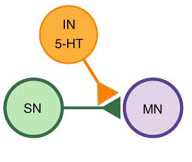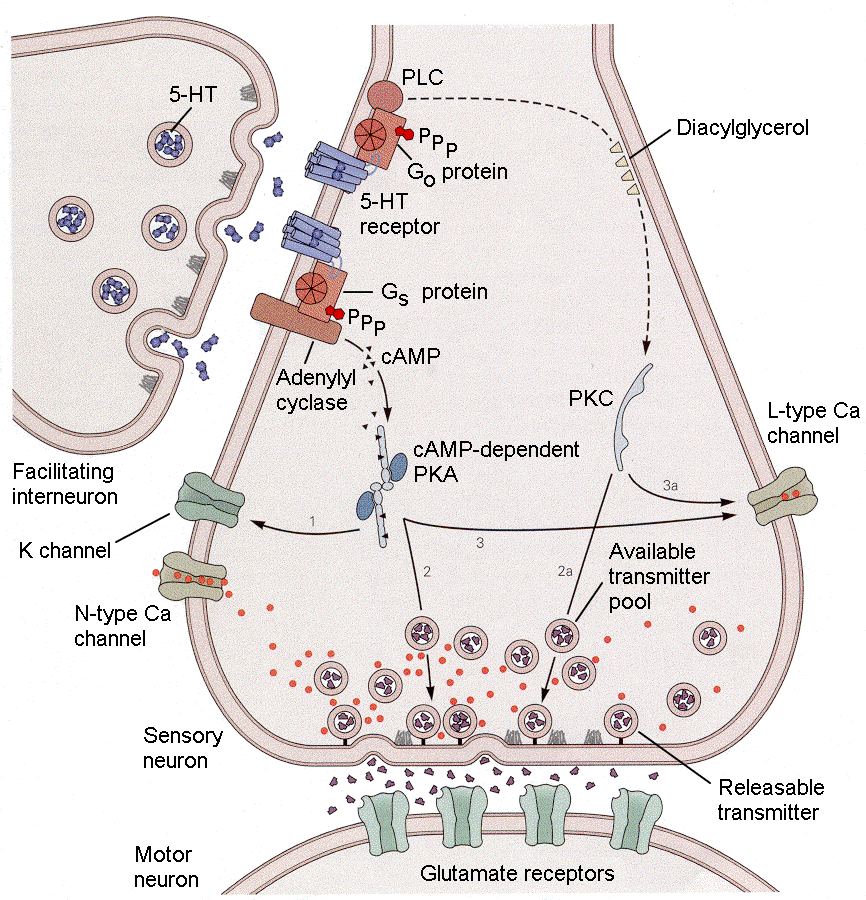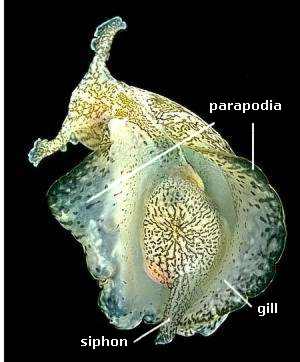Behavioral Neuroscience, lecture on Aplysia and its behavior
Siphon Withdrawal
VIII. Gating
A. Behavioral circuitry is completed, enhanced or limited
1. Via Interneuron neurochemical modification
a. often with neuromodulators or receptors
b. or hormones
2. sensitization may be required for a circuit to be complete
a. priming
i. gradient vs threshold
B. Output of behavioral circuitry is modified
1. altered, repeated, delayed, sped up
a. may require additional circuitry
i. interneurons
ii. brain/ganglia
b. temporal/spatial summation of sensory/interneuron
synaptic potentials
i. cause motor cells to discharge repeatedly
2. Learning
a. synaptic plasticity
i. formation of new synapses
ii. strengthening synaptic connections
(1) unsilencing synapses
(a) adding AMPA to
NMDA-only synapses
(2) increasing(a)/decreasing(b) synaptic current
(a) LTP long-term potentiation
or LTS long-term sensitization
(b) LTD long-term depression
C. Elementary forms of learning:
habituation, sensitization, classical conditioning
1. Habituation = simplest form of implicit learning
a. novel stimulus
i. initial response = attention, orientation toward
b. repeated exposure
i. if neither harmful nor beneficial
c. it is ignored = habituation
d. habituation leads to decrease in the stregth of the synaptic
connections between excitatory interneurons and motor neurons
2. repeated stimulation of gill or tail results in habituation of Aplysia
withdrawal reflexes
a. progressively smaller excitatory synaptic
potentials in interneurons/motor neurons
i. due to a ß number of Glu vesicles released
from presynaptic sensory neurons
(1) no D in AMPA or NMDA receptors
b. cellular mechanism for learning short-term memory
i. 1 session = 10 tactile stimuli to siphon
Þ habituation for minutes
ii. naive Aplysia 90% of sensory neurons synapse
on gill motor neurons
(1) \ monosynaptic plasticity
c. long-term memory
i. 4 sessions Þ habituation for 3 wks
3. Enhancement of synaptic inhibition could also contribute to habituation
a. inhibitory interneurons
i. with long-term habituation in Aplysia only 30%
of sensory neurons synapse on gill motor neurons
4. Not all synapses are equally adaptable
D. Elementary Learning: Sensitization
1. harmful stimulus Þ more vigorous response
2. short term sensitization
a. single shock to Aplysia tail Þ Ý excitatory sensory output
lasting minutes
b. heterosynaptic process
i. 5-HT interneuron increases presynaptic
Glu output of sensory terminal
c. 5-HT Synapse on Sensory bouton
 i. action of 5-HT terminal has direct immediate effect
on Glu Sensory-Motor synapse
d. 5-HT binds to 2 kinds of 5-HT receptors
i. 5-HT2-like receptors Þ Ý Gp Þ Ý PLC Þ Ý IP3/DG Þ
Ý PKC + Ca++
ii. 5-HT4/6/7-like receptors Þ Ý Gs Þ Ý AC Þ Ý cAMP Þ
Ý PKA
e. Ý PKA Þ ß K+ channel current
i. Ý Ca++ influx
f. Ý PKA + PKC + Ca++ release Glu vesicles from pool
i. enhance binding at active zones
g. \Ý Glu stimulated postsynaptic current
3. long-term sensitization (LTS is similar to LTP)
a. 5 shocks Þ Ý excitatory current
lasting days to weeks
b. persistent 5-HT4/6/7-like activation of cAMP/PKA
i. PKA activates CREB cAMP Response Element Binding Protein
ii. CREB binds CRE on DNA
iii. new proteins and long-term memory
E. Classical Conditioning
1. learning by associating one type of stimulus with another
2. pairing an non-salient stimulus with salient stimulus
a. salient stimulus directly causes a behavior
b. non-salient stimulus associated with the salient stimulus
indirectly elicits behavior
i. action of 5-HT terminal has direct immediate effect
on Glu Sensory-Motor synapse
d. 5-HT binds to 2 kinds of 5-HT receptors
i. 5-HT2-like receptors Þ Ý Gp Þ Ý PLC Þ Ý IP3/DG Þ
Ý PKC + Ca++
ii. 5-HT4/6/7-like receptors Þ Ý Gs Þ Ý AC Þ Ý cAMP Þ
Ý PKA
e. Ý PKA Þ ß K+ channel current
i. Ý Ca++ influx
f. Ý PKA + PKC + Ca++ release Glu vesicles from pool
i. enhance binding at active zones
g. \Ý Glu stimulated postsynaptic current
3. long-term sensitization (LTS is similar to LTP)
a. 5 shocks Þ Ý excitatory current
lasting days to weeks
b. persistent 5-HT4/6/7-like activation of cAMP/PKA
i. PKA activates CREB cAMP Response Element Binding Protein
ii. CREB binds CRE on DNA
iii. new proteins and long-term memory
E. Classical Conditioning
1. learning by associating one type of stimulus with another
2. pairing an non-salient stimulus with salient stimulus
a. salient stimulus directly causes a behavior
b. non-salient stimulus associated with the salient stimulus
indirectly elicits behavior


 i. action of 5-HT terminal has direct immediate effect
on Glu Sensory-Motor synapse
d. 5-HT binds to 2 kinds of 5-HT receptors
i. 5-HT2-like receptors Þ Ý Gp Þ Ý PLC Þ Ý IP3/DG Þ
Ý PKC + Ca++
ii. 5-HT4/6/7-like receptors Þ Ý Gs Þ Ý AC Þ Ý cAMP Þ
Ý PKA
e. Ý PKA Þ ß K+ channel current
i. Ý Ca++ influx
f. Ý PKA + PKC + Ca++ release Glu vesicles from pool
i. enhance binding at active zones
g. \Ý Glu stimulated postsynaptic current
3. long-term sensitization (LTS is similar to LTP)
a. 5 shocks Þ Ý excitatory current
lasting days to weeks
b. persistent 5-HT4/6/7-like activation of cAMP/PKA
i. PKA activates CREB cAMP Response Element Binding Protein
ii. CREB binds CRE on DNA
iii. new proteins and long-term memory
E. Classical Conditioning
1. learning by associating one type of stimulus with another
2. pairing an non-salient stimulus with salient stimulus
a. salient stimulus directly causes a behavior
b. non-salient stimulus associated with the salient stimulus
indirectly elicits behavior
i. action of 5-HT terminal has direct immediate effect
on Glu Sensory-Motor synapse
d. 5-HT binds to 2 kinds of 5-HT receptors
i. 5-HT2-like receptors Þ Ý Gp Þ Ý PLC Þ Ý IP3/DG Þ
Ý PKC + Ca++
ii. 5-HT4/6/7-like receptors Þ Ý Gs Þ Ý AC Þ Ý cAMP Þ
Ý PKA
e. Ý PKA Þ ß K+ channel current
i. Ý Ca++ influx
f. Ý PKA + PKC + Ca++ release Glu vesicles from pool
i. enhance binding at active zones
g. \Ý Glu stimulated postsynaptic current
3. long-term sensitization (LTS is similar to LTP)
a. 5 shocks Þ Ý excitatory current
lasting days to weeks
b. persistent 5-HT4/6/7-like activation of cAMP/PKA
i. PKA activates CREB cAMP Response Element Binding Protein
ii. CREB binds CRE on DNA
iii. new proteins and long-term memory
E. Classical Conditioning
1. learning by associating one type of stimulus with another
2. pairing an non-salient stimulus with salient stimulus
a. salient stimulus directly causes a behavior
b. non-salient stimulus associated with the salient stimulus
indirectly elicits behavior